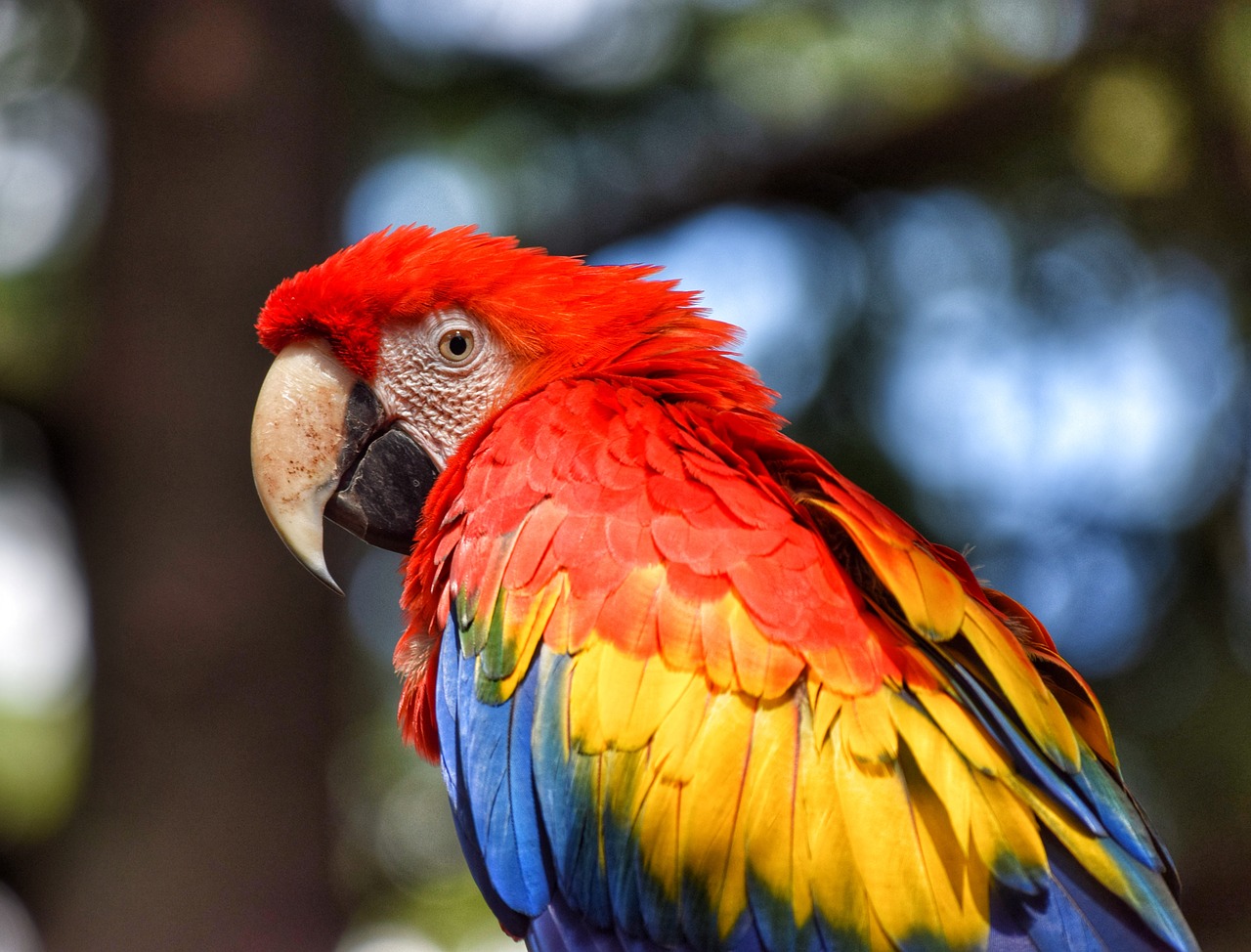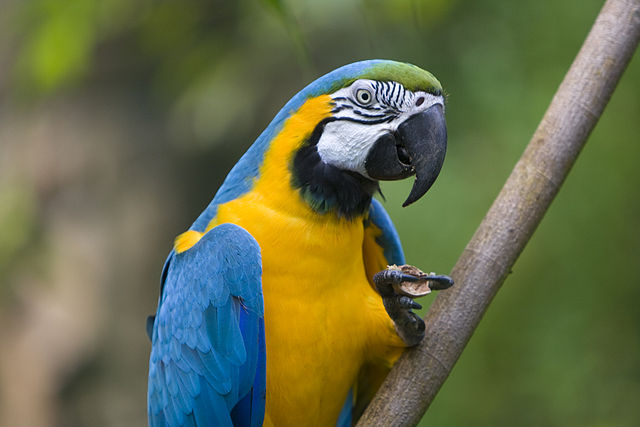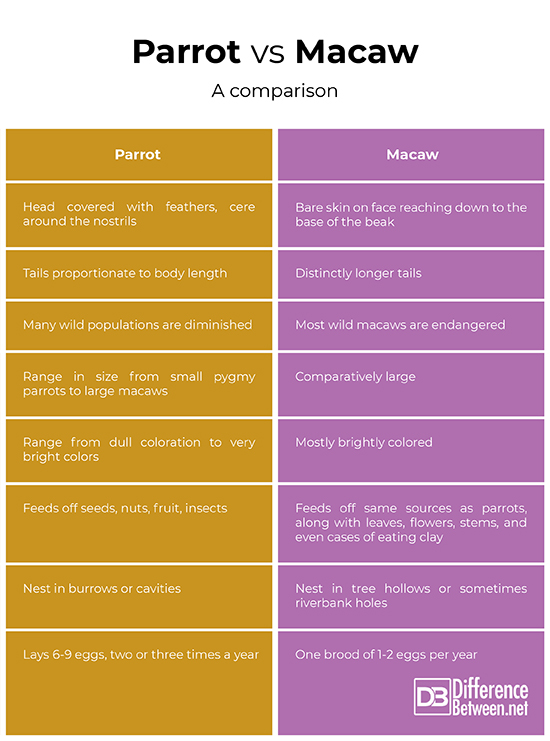Difference Between Parrot and Macaw
Both parrots and macaws belong to one of the largest bird orders, the Psittaciformes, which includes all cockatoos, macaws, parakeets, and parrots. This bird family is quite diverse with more than 350 different species. All the members of this family have a flexible, muscular tongue in a thick hooked beak and zygodactyl claws (two of the toes facing backward, two forward). This combination of features clearly set them apart from other bird types. There are three subgroups, one of which is the Psittacoidea, or the “true” parrots. Both parrots and macaws belong to this group, although they do differ considerably.
What is a Parrot?
A parrot is a general term for all the birds belonging to the Psittacoidea. These birds include various forms ranging between 3.5 to 40 inches, from small parakeets to the large macaws. All parrots have unique bills, a cere around the nostrils (area of soft skin), grasping feet and often live in gregarious groups. There are rarely any visual differences between male and female parrots.
Parrots have a varied diet of mostly seeds, but also including nuts, fruit, nectar, and insects. The sound they can produce vary greatly, from short squawks to melodious songs in some cases and many distinctive vocalizations. These sounds are used for communication in flocks along with the movement of tail feathers. The behavioral ecology is complex and these birds are very social, exhibit lifetime monogamy and are intelligent and with a large capacity for learning. They can be found in an extremely diverse range of habitat, from desert to urban jungle.
The parrots produce up to 6-9 eggs per brood and this takes around 19-30 days to incubate. The hatchlings are completely dependent on the parents and stay in the nest for a prolonged period, while the parents feed them by regurgitation.
What is a Macaw?
Big, colorful and very intelligent, these are the largest kind of parrots. These more closely related to smaller parakeets than other parrots. The macaws are New World parrots and are distributed through most of South America up to central Mexico. To see a group of these colorful birds in flight is a sight unambiguously associated with large rainforests.
Macaws have a distinct section of bare skin, sometimes interrupted with fine rows of feathers, over its face and reaching down to the base of the bill. This characteristic sets them apart from other kinds of parrots, which only have a comparatively small cere around the nostrils. The intricate lines of fine feathers that cross this bare patch of skin have been proven unique to each macaw, much like the human fingerprint. Another feature that distinguishes the macaws from other parrots are the distinctly long tail feathers. There are six genera of macaws, with about 18 species.
These birds live in familiar flocks and feed off nuts and seeds, cracking them open with strong beaks. The presence of these flocks in a rainforest reflects the health of the trees and ultimately the forest.
Unfortunately, the majority of wild macaws are endangered, with 5 species that have already been declared extinct. The threats the macaws are facing include loss of habitat due to deforestation, and the illegal pet trade, where many birds die before they even reach the pet store.
Differences Between a Parrot and Macaw
Classification of Parrot and Macaw
Parrots are a large grouping of birds with similar traits (the order Psittaciformes), which includes bird types such as parakeets, cockatoos, and macaws. The true parrots belong to the family Psittacidae. Of this family, six genera are classified as macaws. The macaws are thus a type of parrot, in the subfamily Arinae.
Distribution
Parrots, in general, have a wide geographical range, and can be found mainly in the Southern hemisphere in a variety of habitats, and are not limited to the tropical regions. Some are migratory and form breeding colonies in certain areas. The macaws, on the other hand, are found in the tropical rainforests or woodland areas from central Mexico down to South America where they live and breed.
Biology
Parrots feed off seeds, nuts, fruit, nectar, and insects. The macaws have a large foraging range and feed off similar sources along with certain stems, leaves, flowers, and palm fruit. Macaws in the Amazon have also been observed to eat clay to neutralize certain substances from their dietary sources. Parrots are monogamous and often nest in burrows. Macaws also have one mate for life and nest in tree hollows or sometimes riverbank holes. Large parrots like macaws take a few years to reach maturity and reproduce at a slow rate, with only one or two hatchlings a year and not necessarily every year. Smaller parrots lay more eggs, up to 6-9, and with two or three broods per year.
Morphology of Parrot and Macaw
Parrots have a wide variety of forms, while in comparison to other parrots, macaws are proportionately large with a long tail, and have bare facial patches (often light-colored).
Parrot vs Macaw: A Comparison
Summary of Parrot Vs. Macaw
- Parrots are a large avian group that include cockatoos, parakeets, parrots and macaws
- All parrots have zygodactyl feet, a cere around the nostrils and a flexible tongue in a hooked beak
- A macaw is a distinct type of parrot
- Parrots are gregarious and occur in a wide range of habitats
- All parrots are monogamous
- Macaws are larger with long tail feathers and a bare patch of skin on the face
- These kinds of parrots are limited to rainforests
- Parrot populations are diminishing and all macaw species are endangered
- All parrots face dangers of habitat loss and illegal pet trade
- Macaws breed less than other parrots and with much smaller broods
- Difference Between Bactericidal and Bacteriostatic - November 29, 2018
- Dfference Between COPD and Smoking - November 19, 2018
- Difference Between Parasites and Bacteria - November 13, 2018
Search DifferenceBetween.net :
Leave a Response
References :
[0]Joseph, Leo, et al. "A revised nomenclature and classification for family-group taxa of parrots (Psittaciformes)." Zootaxa 3205.2 (2012): 26-40.
[1]Seibert, Lynne M. "Social behavior of psittacine birds." Manual of parrot behavior (2006): 43-48.
[2]Toft, Catherine A., and Timothy F. Wright. Parrots of the wild: A natural history of the world's most captivating birds. Univ of California Press, 2015.
[3]Image credit: https://pixabay.com/en/parrot-bird-volatile-color-2791686/
[4]Image credit: https://upload.wikimedia.org/wikipedia/commons/thumb/7/7e/Blue-and-yellow_Macaw_%28Ara_ararauna%29_-9.jpg/640px-Blue-and-yellow_Macaw_%28Ara_ararauna%29_-9.jpg



